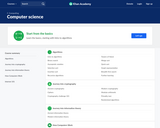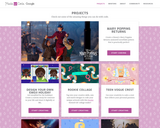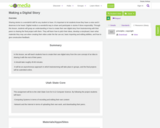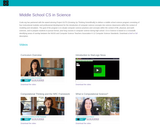
Learn the basics, starting with Intro to algorithms.
- Subject:
- Computer Science
- Science
- Material Type:
- Full Course
- Provider:
- Khan Academy
- Date Added:
- 05/02/2019


Learn the basics, starting with Intro to algorithms.

In this video segment adapted from the Massachusetts Institute of Technology, researchers in the Artificial Intelligence Laboratory working to engineer smarter robots are now building a machine that interacts socially with people.

In this segment adapted from ZOOM, cast members use computers to program a robot in preparation for the FIRST LEGO League Challenge tournament. Despite meticulous planning and programming by its designers, an autonomous robot can encounter unexpected challenges. This is true for both LEGOŰ_í__ robots and Martian rovers. In this video segment adapted from ZOOM, cast members enter the FIRST LEGOŰ_í__ League Challenge tournament and work as a team to program their LEGOŰ_í__ robot to navigate a complex obstacle course. Grades 3-8.

Make Stuff Move wants students to use tools and everyday materials to learn and develop hands-on skills in building and being creative while solving problems. STEM/STEAM is great but it is even better when tools are involved!
This Learning Library includes:
*Lesson Plans
*How-to Instructions
*Coding
& More!
(Kits are available for purchase on the site as well)

Check out some of the amazing things you can do with code.

How to adjust where the start and end position for a servo motor inside a Servo Sock.

Analog meters are all around us!. They are used to visually represent measurements and data. One of the most common analog meters is the fuel needle in a car. This converts a reading of the fuel level in the tank to an empty to full reading on the meter.
In this build, we will use one servo to build an electronically controlled meter. We will first simply use the knob on the control the board to move the needle converting the knob position to movement of the needle. Then, a sound sensor will be connected to convert sound level (ie music) to a meter reading. This will make it what is commonly known as a “VU-meter”
SKILLS + GOALS
Carpentry
- Use of basic tools and hardware
Construction
- Following visual assembly instructions
Code
- Understand math/code behind converting input readings to output readings (meter)
& more!
** Kits are available for purchase at makestuffmove.com **

Welcome to Make Stuff Move coding lessons. This first lesson is going to show you how to set the colour and brightness of the pixel and turn it on, on our Make Stuff Move animate shield.

Welcome to another Make Stuff Move coding lesson. This second lesson is going to show you how to move a servo using the knob on your animate shield.

A quick review of some general fastening techniques.

This build works out to be useful in two ways; flinging stuff and drumming on stuff. The overall concept is to increase the inertia of the moving servo by quickly snapping the cable tie to flick the arm. The mechanics of this build is modeled after a foot pedal used in a drum kit.
The flinging aspect is just fun. Fling coins, buttons and ping-pong balls. When using the animation recording feature of the Animate Shield, beats can be recorded an looped including adjusting the speed.
SKILLS + GOALS
Construction
-Build the project following assembly instructions
Music
-Animate a beat
Carpentry
-Basic carpentry principals and hardware
Coding
-Learn about using delays in code to control movement timing
& More!
** kits available for purchase at makestuffmove.com**

Build a mechanical flower that opens up when there is light. This flower uses a few interesting mechanical movements including a push-pull cable to convert rotational movement into a linear movement for a flexible stem. Then the movement is converted back to rotational pivot points to open and close the pedals. The use of the binder clips also means that you are free to create your own flower petals.
SKILLS + GOALS
Construction
- Build the project following assembly instructions
Carpentry
- Basic carpentry principals and hardware
Art + Design
- Create and design your own flower petals
Coding

Build a mechanical heart that uses a pulse sensor to make the heart beat with yours
SKILLS + GOALS
Construction
- Build the project following assembly instructions
Carpentry
- Basic carpentry principals and hardware
Coding
& More!
** Kits are available for purchase at makestuffmove.com **

Inchworms are so simple in their movement which makes it a fun challenge to build and animate their movement. The inchworm shifts its weight during its "pinching/folding" to push the front and pull the back.
SKILLS + GOALS
Construction
-Build the project following assembly instructions
Carpentry
-Basic carpentry principals and hardware
Animation
-Learn how to animate a single cycle of movement to create continuous movement.
& More!
** Kits are available for purchase at makestuffmove.com **

How to use the features of our SOCK IO + Animate shield combo.

Welcome to Make Stuff Move! The following diagram will get things moving quickly.

Sharing stories is a wonderful skill for any student to have. It's important to let students know they have a voice and it deserves to be heard. Digitial media is a wonderful way to share and participate in stories if done responsibly. Through this lesson, students will grasp an understanding in how to create their own digital story from brainstorming with their peers to sharing the final project with them. They will learn how to pitch their ideas, develop a storyboard, learn what materials they may use when creating their video under the fair use act, basic importing and editing abilities, and how to give constructive feedback.

Code.org has partnered with the award-winning Project GUTS (Growing Up Thinking Scientifically) to deliver a middle school science program consisting of four instructional modules and professional development for the introduction of computer science concepts into science classrooms within the context of modeling and simulation. The goal of the program is to situate computer science practices and concepts within the context of life, physical, and earth sciences, and to prepare students to pursue formal, year-long courses in computer science during high school. CS in Science is based on a crosswalk identifying areas of overlap between the NGSS and Computer Science Teachers Association K-12 Computer Science Standards. Download a brief or fulldescription.

In this media-rich lesson plan, students explore how to keep their digital lives safe, spot cyber scams, and learn the basics of coding from NOVA Labs. The lesson begins with students watching the Cybersecurity 101 video and discussing the online safety measures that they currently take. Next, students make predictions about online safety best practices, complete the Level 1 challenges of the NOVA Cybersecurity Lab, and compare the best practices from the game with their predictions. Students reconvene for direct instruction on the best practices and key computer science terms, and then finish the Cybersecurity Lab game. Finally, students complete the video quizzes with short-response discussion questions and can work on the Cybersecurity stories as homework reading assignments.

This lesson centers around the How AI Works: Neural Networks video from the How AI Works video series. Watch this video first before exploring the lesson plan.
Students learn how neural networks work. They first discuss an example of an experience that recommends things to you. They then use a widget that recommends videos based on one person. Students watch a video explaining neural networks. They use an updated widget to adjust the weights of each person. Finally, students discuss the need for diverse perspectives when creating recommendation systems.
This lesson can be taught on its own, or as part of a 7-lesson sequence on How AI Works. Duration: 45 minutes